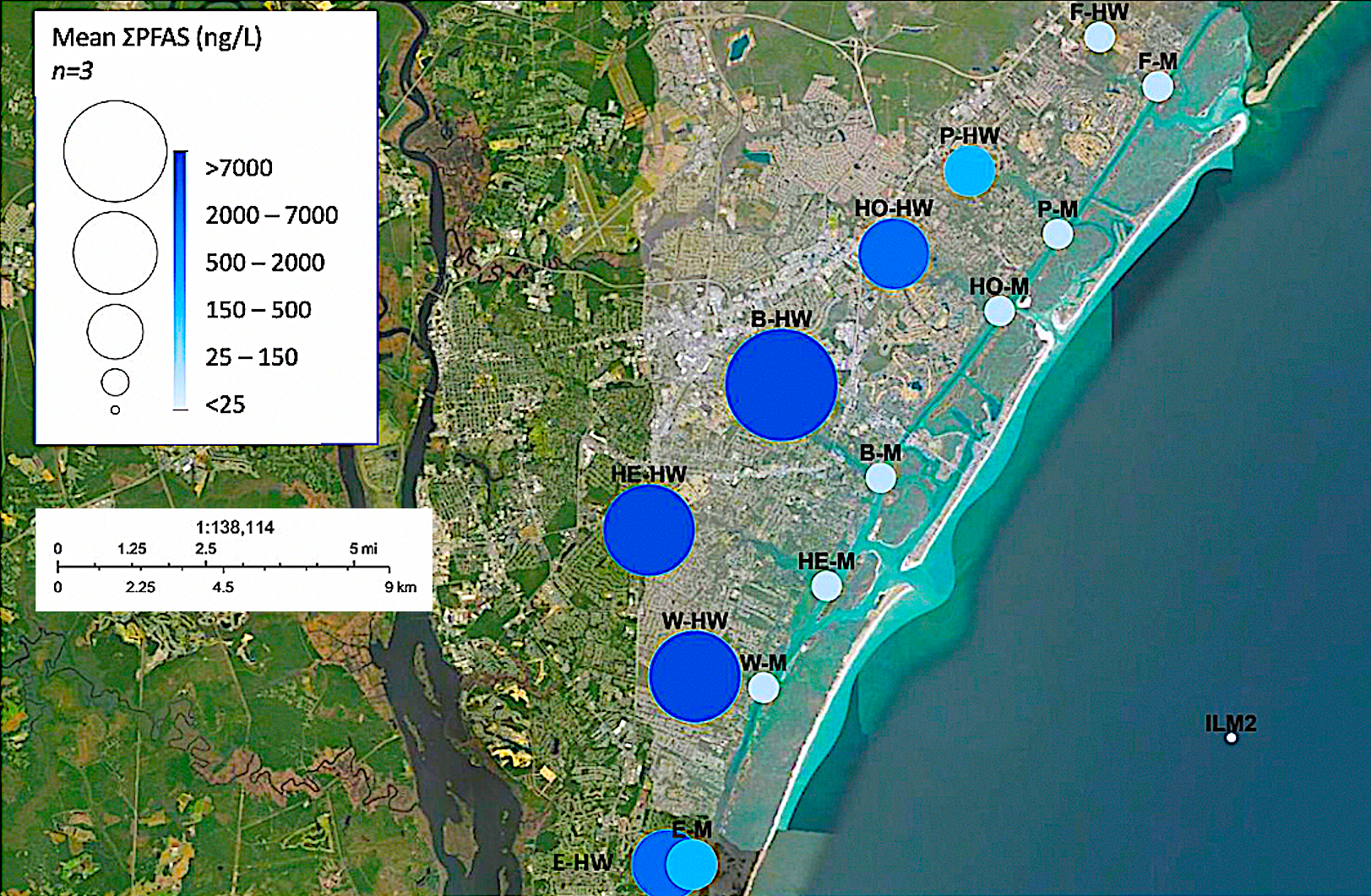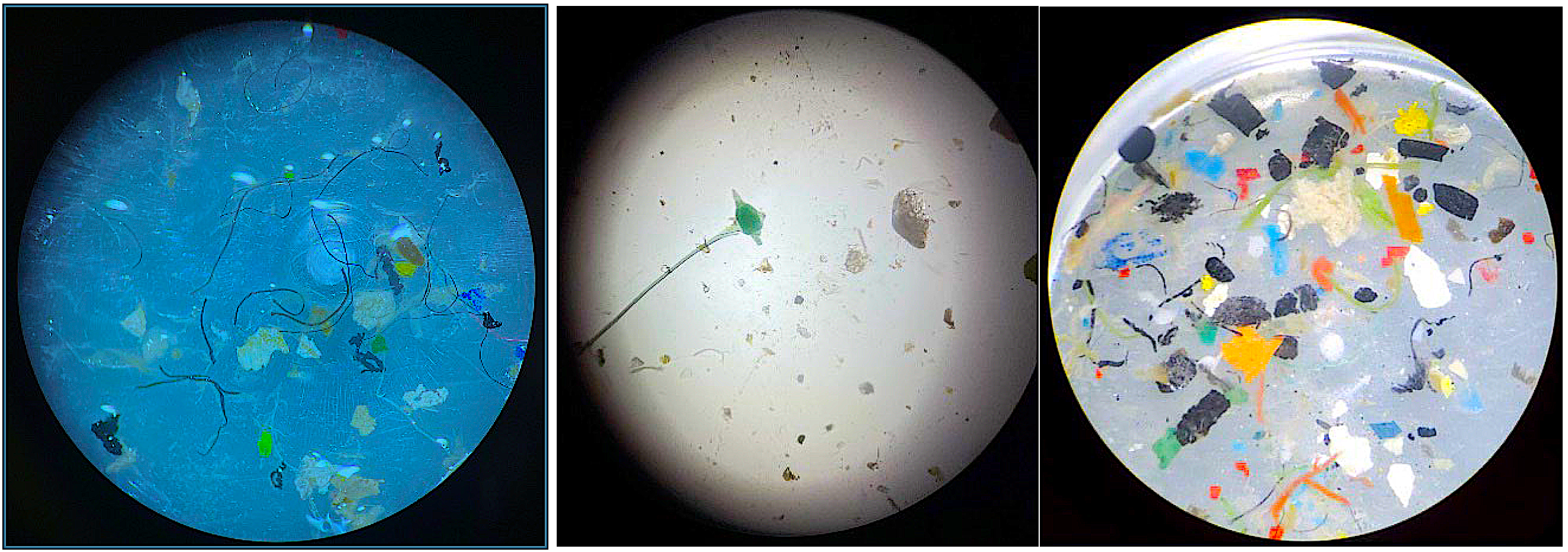Emerging Contaminants: PFAS in the Tidal Creeks of Southeastern North Carolina

Since the industrial revolution, the introduction of countless contaminants to the environment has led to a measurable chemical “pollution fingerprint” that is present in soil, water, air, and organisms. One of the most recent groups of contaminants that have become a part of that chemical pollution fingerprint are perfluoroalkyl and polyfluoroalkyl substances (PFAS).
PFAS include thousands of man-made organic compounds with unique characteristics — such as high thermal stability, water and oil repellency, and other properties — which makes them useful for products like aqueous film-forming foams, nonstick coatings, fast food wrappers, and water-resistant clothing. The properties that make PFAS useful also make them very mobile and resistant to breaking down in the environment.
Widespread production and use, combined with limited enforceable regulations since the 1940s, has led to a global distribution of PFAS. Today, PFAS can be found in nearly every corner of the globe, even places that are far from any known sources.

In recent years, PFAS contamination in drinking water sources has become a global concern, due to associated adverse human health effects, including in North Carolina. In addition to drinking water, PFAS are also present in our state’s groundwater, surface water, air, plants, and animals.
Most PFAS research in North Carolina to date has focused on the Cape Fear River Basin and its tributaries; however, there is limited understanding of PFAS contamination in the small but abundant tidal creeks that are characteristic of the North Carolina coastline.
The four southernmost coastal counties in North Carolina alone (Onslow, Pender, New Hanover, and Brunswick) are home to more than 73 tidal creeks of varying sizes. Several of these creeks drain small upland areas to larger estuaries, such as the Atlantic Intracoastal Waterway, and they are beneficial to coastal communities due to their ability to protect from erosion, filter contaminants, and provide habitat for plants and animals. The combined impact of these tidal creeks in the transport of contaminants from the land to the sea could exceed that of larger rivers or estuaries because of their widespread abundance.
For the first time, researchers from the University of North Carolina at Wilmington have been working to measure PFAS in the surface waters of tidal creeks in New Hanover County. In summer of 2022, our team collected surface water samples from seven tidal creeks to analyze for 16 perfluoroalkyl and polyfluoroalkyl substances. We sampled two sites for each tidal creek, one in the upper reaches of the drainage basin (the “headwater”) and one in the lower portion of the tidal creek where it meets the Atlantic Intracoastal Waterway (the “mouth”).
Results revealed that PFAS were present in the surface waters of all the sampling sites on all dates.
In addition, concentrations were generally lower at the mouth sampling sites compared to the headwater sampling sites. This finding suggests that PFAS contamination is originating from the inland areas of the tidal creek drainage basins. The exact source of PFAS to the tidal creeks, however, is not well defined due to the highly dynamic nature of these areas.
Mean total PFAS concentration — that is, the sum of all 16 compounds we measured — was higher than 7000 nanograms per liter in some of the sampling sites. Many of the sites contained PFAS concentrations that were higher than levels set by the EPA for PFAS in drinking water, but there are currently no regulations for PFAS in the environment.

This map shows the average total PFAS concentrations that we measured at each site, as well as a sample we took offshore at “ILM2,” where PFAS was present at low levels.
Although these tidal creeks are not drinking water sources, they are commercially, recreationally, and ecologically valuable parts of our coastline. PFAS have the potential to interact with bottom sediments, vegetation, and marine organisms within complex tidal creek and salt marsh systems. Further research will help us understand the human and environmental risks associated with PFAS in tidal creeks and the role that these systems play in PFAS transport.
more on PFAS and other contaminants
“Troubled Waters,” Autumn 2022 Coastwatch
EMMA CORBITT was co-winner of the poster session at North Carolina Sea Grant’s 2022 NC Coastal Conference. She graduated this spring with a masters in marine science from UNCW.
The author wishes to acknowledge the Environmental Organic Geochemical Laboratory, the Center for Marine Science, and the Department of Earth and Ocean Sciences at UNCW for their support.
- Categories:


